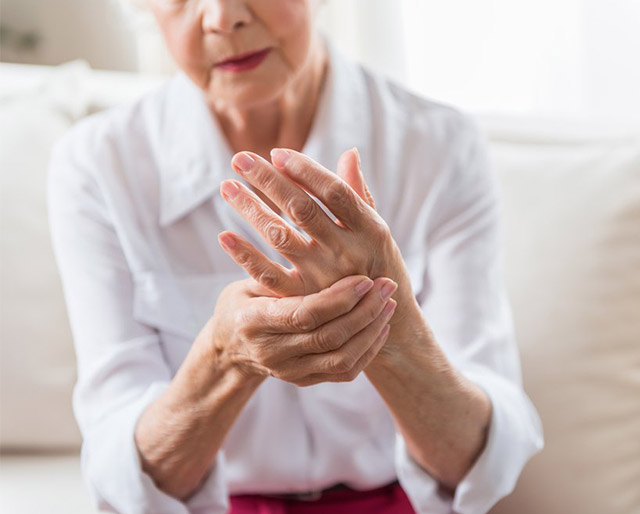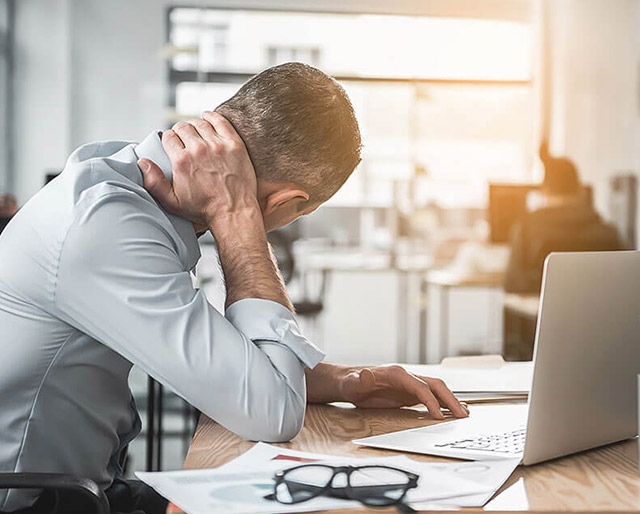There are over 50 million U.S. adults and 1.5 billion people globally with chronic pain conditions. 20 million more have high-impact chronic pain, which limits work, social, recreational and self-care activities. (1) Chronic joint and back pain are the top 2 causes of disability in the U.S. (2) and the prevalence is only rising.(2)


A conservative estimate of the annual cost of chronic pain in America is $560-635 billion dollars with $300 billion of that being incremental healthcare costs and the rest, lost productivity in the workplace. Those with moderate pain spend $4,516 more annually than those without pain and those with severe pain spend $3,210 more than those with moderate pain. (1) In 2014, $45 billion was spent on back surgery alone.(3)
Whether it is surgery, injections, pharmacology or physical therapy, randomized, controlled studies show that standard treatments for chronic pain show little to no efficacy, (refs) yet continue to be employed. Studies of standard psychotherapeutic approaches, such as Cognitive Behavioral Therapy (CBT) and Acceptance and Commitment Therapy (ACT) also show limited to no efficacy for chronic pain. A 2020 Cochrane Review showed that for CBT, the average pain decreased by an equivalent of 0.4 on a 0-10 pain analogue scale and for ACT, by an equivalent of 0. (30)

We must stop treating all pain the same. Cancer pain is not the same as structural pain which is not the same as centralized or neural circuit pain. We don’t treat all cancers the same. Why do we treat all pain the same?
Medical research shows that joint pathology is found in most people who have never had pain. In fact, spine changes on MRI begin in our 20’s and continue over the lifetime, but do not necessarily cause pain. Could many MRI findings reveal normal aging of the spine and joints? Damaged tissue does not necessarily cause pain and pain does not always result from tissue damage. Could there be other causes of pain?
Increasingly, research is showing us that the brain can not only modulate pain, but can actually cause pain and stop pain through the alteration of learned neural circuits.
Is our lack of success in treating chronic pain due to the pain’s intractability or due to our unwillingness to view pain and its treatment through a different lens – a psychosocial lens, instead of a biomedical lens? Are we looking in the wrong place for the answer? Could most chronic pain be caused by learned neural pathways in the brain which, like a light switch, can be dimmed, turned on or turned off, by altering the brain’s neural pathways?
What if psychosocial drivers were the sole cause of the pain or at least, major contributors? Would we, as compassionate healers, be willing to address these issues with our patients? Do we have the knowledge to understand, diagnose and treat these conditions? Do we know how to communicate with our patients about these conditions in ways that are not offensive or demeaning? Do we know how to direct our patients to the appropriate treatment?
OvidDx is the solution for you and your patients. With all training program content based on the latest medical pain research and with multiple peer-reviewed randomized controlled trials showing efficacy for our approach, you will be newly empowered to offer your patients life-transforming help. As healers committed to helping your patients thrive, everyone wins.
Learn MoreInstitute of Medicine. (2011). Relieving Pain in America: A Blueprint for Transforming Prevention, Care, Education, and Research.
Hartvigsen, J., Hancock, M. J., Kongsted, A., Louw, Q., Ferreira, M. L., Genevay, S., … Woolf, A. What low back pain is and why we need to pay attention. The Lancet, 2018, 391: 2356-2367.
Martin BI, Mirza SK, Spina N, Spiker WR, Lawrence B, Brodke DS. Trends in lumbar fusion procedure rates and associated hospital costs for degenerative spinal conditions in the United States, 2004 to 2015. SPINE. 2019, 44: 369-376
Bennell, K. L., et al. (2021). “Effect of Intra-articular Platelet-Rich Plasma vs Placebo Injection on Pain and Medial Tibial Cartilage Volume in Patients With Knee Osteoarthritis: The RESTORE Randomized Clinical Trial.” JAMA 326(20): 2021-2030.
Brox I, Reikeras O, Nygaard O, Sorensen R, Indahl A, Holm I, Keller A, Ingebrigtsen T, Grundnes O, Lange JE, Friis A. Lumbar instrumented fusion compared with cognitive intervention and exercises in patients with chronic back pain after previous surgery for disc herniation: A prospective randomized controlled study. PAIN. 2006, 122; 145-155.
Chou R, Stanos SP, Rosenquist RW. Nonsurgical interventional therapies for low back pain: a review of the evidence for an American Pain Society clinical practice guideline. Spine (Phila PA, 1976). 2009, 34: 1078-1093.
Chou, R., et al. (2015). “The effectiveness and risks of long-term opioid therapy for chronic pain: a systematic review for a National Institutes of Health Pathways to Prevention Workshop.” Ann Intern Med162(4): 276-286.
Deyo RA, Mirza SK, Turner JA, Martin BI. Overtreating chronic back pain: time to back off? Journal of the American Board of Family Medicine. 2009, 22: 62-8.
Deyo RA. Watch Your Back: How the back pain industry is costing us more and giving us less. Cornell University Press, Ithaca, NY. 2015.
Dowell, D., et al. (2016). “CDC Guideline for Prescribing Opioids for Chronic Pain–United States, 2016.” JAMA315(15): 1624-1645.
Friedly JL, Comstock BA, Turner JA, et. al. A randomized trial of epidural glucocorticoid injections for spinal stenosis. New England Journal of Medicine. 2014, 371: 11-21.
Jonas, W. B., et al. (2019). “Are Invasive Procedures Effective for Chronic Pain? A Systematic Review.” Pain Med 20(7): 1281-1293.
Jung A, Shin BC, Lee MS, Sim H, Ernst E. Acupuncture for treating temporomandibular joint disorders: A systematic review and meta-analysis of randomized, sham-controlled trials. Journal of Dentistry. 2011, 39: 341-350.
Keller RB, Atlas SJ, Soule DN, Singer DE, Deyo RA. Relationship between rates and outcomes of operative treatment for lumbar disc herniation and spinal stenosis. Journal of Bone and Joint Surgery. 1999, 81: 752-762.
Krebs EE, Gravely A, Nugent S, et al. Effect of Opioid vs Nonopioid Medications on Pain-Related Function in Patients With Chronic Back Pain or Hip or Knee Osteoarthritis Pain: The SPACE Randomized Clinical Trial. JAMA. 2018;319(9):872–882. doi:10.1001/jama.2018.0899
Lam M, Galvin R, Curry P. Effectiveness of Acupuncture for Nonspecific Chronic Low Back Pain: A Systematic Review and Meta-analysis. Spine. 2013, 38: 2124-2138. doi: 10.1097/01.brs.0000435025.65564.b7
Mitra S. Opioid-induced hyperalgesia: Pathophysiology and clinical implications. Journal of Opioid Management. 2008, 4: 123-130.
Nguyen TH, Randolph DC, Talmage J, Succop P, Travis R. Long-term outcomes of lumbar fusion among workers’ compensation subjects: a historical cohort study. Spine. 2011, 36: 320-31.
O’Brien, M. D. C. and A. P. F. Wand. “A systematic review of the evidence for the efficacy of opioids for chronic non-cancer pain in community-dwelling older adults.” Age Ageing (2020), 49 (2): 175-183.
Osterman H, Seitsale S, Karppinen J, Malmivaara A. Effectiveness of microdiscectomy for lumbar disc herniation: A randomized, controlled trial with two years of follow up. Spine. 2006, 31:2409–2414.
Raphael, K. G., et al. (2012). “Sleep bruxism and myofascial temporomandibular disorders: a laboratory-based polysomnographic investigation.” J Am Dent Assoc143(11): 1223-1231.
Shadbolt C., et al. (2020). “Opioid Use and Total Joint Replacement.” Curr Rheumatol Rep 22(10): 58.
Silverman SM. Opiod induced hyperalgesia: Clinical implications for the pain practitioner. Pain Physician. 2009, 12: 679-684.
Staal JB, deBie RA, deVet HC, Heldebrandt J, Nelemans P. Injection therapy for subacute and chronic low back pain: an updated Cochrane review. Spine (Phila PA, 1976). 2009, 34: 49-59.
Weinstein JN, Tosteson TD, Lurie JD, Tosteson AN, Hanscom B, Skinner JS, Abdu WA, Hilibrand AS, Boden SD, Deyo RA. Surgical vs nonoperative treatment for lumbar disk herniation: the Spine Patient Outcomes Research Trial (SPORT): a randomized trial. Journal of the American Medical Association. 2006, 296: 2441-50.
Weinstein JN, Lurie JD, Tosteson TD, Hanscom B, Tosteson AN, Blood EA, Birkmeyer NJ, Hilibrand AS, Herkowitz H, Cammisa FP, Albert TJ, Emery SE, Lenke LG, Abdu WA, Longley M, Errico TJ, Hu SS. Surgical versus nonsurgical treatment for lumbar degenerative spondylolisthesis. New England Journal of Medicine. 2007, 356: 2257-70.
Welsh P., et al. (2020). “Opioids for chronic osteoarthritis pain: An updated systematic review and meta-analysis of efficacy, tolerability and safety in randomized placebo-controlled studies of at least 4 weeks double-blind duration.” Eur J Pain 24(4): 685-703.
Wilson N, Kariisa M, Seth P, et al. Drug and Opioid-Involved Overdose Deaths–United States, 2017-2018. MMWR Morbidity and Mortality Weekly Report. 2020; 69: 290-297.
Yuan Q, Wang P, Liu L, et. al. Acupuncture for musculoskeletal pain: A meta-analysis and meta-regression of sham-controlled randomized clinical trials. Scientific Reports. 2016, 6, 30675.
Williams, A. C. C., et al. (2020). “Psychological therapies for the management of chronic pain (excluding headache) in adults.” Cochrane Database Syst Rev 8: CD007407.